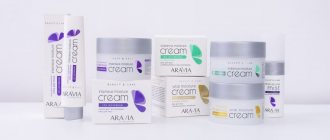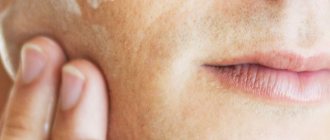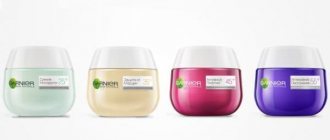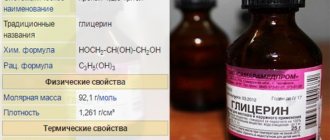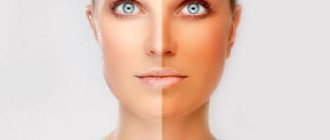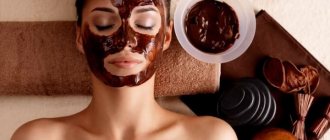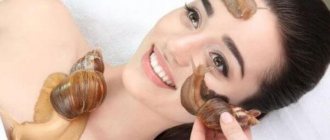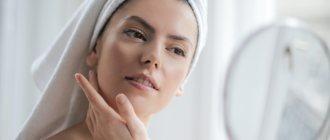Urea is a real superhero in the fight for youthful and beautiful skin. Thanks to its ability to absorb and release moisture, it softens the cells of the stratum corneum and provides deep hydration, stimulates the metabolic processes of the epidermis and prevents flaking. Urea is not only healthy, but also safe, since it is naturally synthesized in the human body. This component is widely used in cosmetics and occupies a special place in the ARAVIA Professional catalog.
The series of products with urea has been replenished with new products:
- renewing cream with urea (10%) and PHA acids ACID-RENEW CREAM;
- lifting cream with urea (10%) and collagen MOISTURE COLLAGEN CREAM;
- moisturizing cream with urea (10%) and ceramides CERA-MOISTURE CREAM.
Urea further reveals its potential in synergy with other active ingredients. New face and body creams from ARAVIA Professional provide skin renewal and restoration, a pronounced rejuvenating effect, effective moisturizing and stimulation of intercellular metabolism.
As part of professional care, they are recommended to be used at the final stage of the procedure; at home, they are recommended to be used daily.
Why skin is dry - reasons.
Of course, she lacks moisture, but this is a consequence, not a cause. A well-known moisturizer like hyaluronic acid will help. But not for long, since the action of hyaluronic acid will be aimed at eliminating the consequences, and not the true causes of dryness.
What makes this type different from the rest? Weakened epidermal barrier, as well as low intensity of sebaceous glands. These qualities determine:
- inability of dry skin to retain moisture,
- increased sensitivity,
- irritability.
Characteristics of this type.
- Thin hydrolipid mantle.
- Thin stratum corneum, low quality natural moisturizing factor (NUF). NUF consists of substances formed as a result of the vital activity of the skin, which, in turn, retain moisture in the upper layers of the epidermis.
- Intercellular lipids are not able to provide a reliable barrier that prevents the evaporation of moisture from internal tissues (lipids fill the space between the scales of the stratum corneum in the epidermal barrier, forming a lipid barrier).
It is the quality of the lipid barrier that distinguishes dry skin from all other types, including dehydrated skin. Dry skin is a type that has a very low quality lipid barrier. Dehydrated skin is a condition that can affect any skin type, even oily skin.
From these characteristics follow the signs by which you can classify and determine this type, as well as choose cosmetics for dry type.
Lifting cream with urea (10%) and collagen MOISTURE COLLAGEN CREAM
The lifting cream has similar packaging and differs only in the color of the design. There is also a branded membrane under the lid.
The cream with urea and collagen has a delicate white texture and, after complete absorption, leaves the skin feeling soft and comfortable. The aroma is close to neutral, with light notes of coconut and plant extracts.
Thanks to the large volume, the product will last for a long time
Protective membrane - first opening control
Urea in cosmetics provides consistency with additional tenderness
Urea in cosmetics provides consistency with additional tenderness
Urea in cosmetics provides consistency with additional tenderness
Cream with urea and collagen
has a pronounced moisturizing effect and is intended for dry, dehydrated skin with signs of age-related changes. Its formula provides noticeable lifting and correction of wrinkles, enhances protective functions and retains moisture in the upper layers of the epidermis. The product instantly improves skin condition, increases tone, eliminates the feeling of tightness and flaking.
Active components:
- urea 10% (hydroxyethylurea)
deeply moisturizes the skin, binds water molecules to each other, preventing their evaporation, stimulates the exfoliation of dead cells and the division of new ones; - Collagen
is present in the human body, so it is quickly integrated into the cells of the epidermis. It increases the firmness and elasticity of the skin, returns it to a healthy and youthful appearance; - coconut oil
slows down the aging process, has an antimicrobial and healing effect, intensively softens and moisturizes the skin; - olive oil
relieves inflammation, has a rejuvenating and antioxidant effect, softens the skin and saturates it with vitamins; - Vitamin E
improves the overall condition of the skin and enhances the effect of anti-age cosmetics.
Mode of application
. Apply the cream to clean and dry face/body skin. Leave until completely absorbed.
Signs of dry skin.
- There is no excessive secretion of sebum.
- Small, narrowed pores. At a young age, the skin may be smooth with a matte surface.
- Thin, “luminous”. Glowing in both a bad and a good way. In good condition, matte and smooth. In bad conditions, the skin is so thin that capillaries appear through it. Has a tendency to rosacea.
- Not prone to breakouts, unlike the oily type.
- Relatively high sensitivity, which means its companions are not pimples, but redness, peeling, and a feeling of tightness.
- Those with dry skin have reduced turgor. This type is prone to early formation of wrinkles. Unfortunately, the signs of aging appear first in the dry type.
Dry skin in youth does not cause much trouble, has an even tone, and, as a rule, pleases its owner. But with age, irritation, flaking, redness appear, and early wrinkles complement the disappointing picture. As a rule, age-related changes manifest themselves in the fine-wrinkled type of aging.
Baalbaki Nada, PhD
Doctor of Pharmaceutical Sciences, Faculty of Biopharmaceuticals, University of Cincinnati, CeraVe brand consultant, USA
One of the main functions of the skin is to form a barrier between the internal environment of the body and the outside world. The skin not only protects against external agents (chemical compounds, physical and mechanical factors, biological pathogens), but also prevents water loss, preventing dehydration [1, 2].
The barrier structures of the skin are localized in the stratum corneum of the epidermis. Corneocytes (dead cells of the stratum corneum) are the foundation of the epidermal barrier, but an equally important function is performed by surface lipids, which can be divided into two fractions:
- lipids of the stratum corneum - located between the horny scales, forming layers (lipid barrier);
- lipids of the secretion of the sebaceous glands (sebum) - are part of the hydrolipidic (or acidic) mantle that covers the skin from the outside.
The formation of protective lipid structures of the stratum corneum occurs gradually as the keratinocyte transforms into a corneocyte [1].
The epidermis has 5 layers: basal, spinous, granular, shiny and horny. Keratinocytes (the main structural cells of the epidermis) originate from the stem cells of the basal layer of the epidermis. As keratinocytes move into the granular layer, many granules are formed in them:
- dark granules contain the protein keratohyalin, from which the main protein of the stratum corneum, keratin, will then be formed, as well as profilaggrin, the precursor of filaggrin* ( * Filaggrin is a structural protein of the skin that is directly involved in the process of keratinization, specifically interacting with intermediate filaments of keratin to organize them into a dense, ordered network that provides the stratum corneum with mechanical strength. - Ed.);
- light granules (lamellar bodies, Odland bodies) are filled with lipids, which play a key role in the formation of the permeability barrier of the stratum corneum, as well as enzymes for their processing.
Lamellar bodies contain mainly sphingolipids, cholesterol, phospholipids, as well as catabolic enzymes and antimicrobial peptides. As the keratinocyte transforms into a corneocyte, lamellar bodies approach the cell membrane, merge with it and spill their contents into the extracellular space. Under the action of simultaneously released enzymes, lipids undergo further metabolism. As a result, glycerol (known for its water-retaining properties) and free fatty acids (FFA) are formed from phospholipids (under the action of phospholipase), and ceramides (CER) are formed from sphingolipids, which assemble into layered structures and form a lipid barrier ( Fig. 1 ) [1 ].
The lipid composition of the stratum corneum is influenced by age, genetic predisposition, season, diet (eg, essential fatty acids), and medications.
The composition of the lipid layers of the stratum corneum will differ from the composition of the lipids of the living layers of the epidermis. If the predominant class of fats in the case of living layers of the epidermis are phospholipids of cell membranes, then in the case of the stratum corneum the dominant positions will be evenly distributed among three types of lipids: CER, cholesterol and FFA, contained in equimolar quantities - 1: 1: 1 (i.e. for one molecule of CER there is one molecule of cholesterol and FFA); The ratios of these lipids per mass are presented in the table.
Table. Mass ratios of various types of lipids in the stratum corneum [3]
| Lipid group | Mass content, % |
| Ceramides | 40–50 |
| Cholesterol | 20–25 |
| Cholesterol sulfate | 5–10 |
| Free fatty acids | 15–20 |
It is the proportion 1: 1: 1 that is considered the most physiological and provides good barrier functions of the stratum corneum.
In addition to these main lipids, the lipid barrier also contains:
- cholesterol sulfate - plays a role in the desquamation of horny scales;
- free sphingoid bases are formed due to the destruction of CER by ceramides, have antimicrobial properties and regulate keratinization processes by inhibiting protein kinase C [1].
Thus, to ensure the structural and barrier integrity of the stratum corneum, not only the qualitative composition is important, but also the balanced ratio of its main components.
Lipid layers are located parallel to each other. They are separated by a thin layer of water, through which water moves towards the surface. This process is called transepidermal water loss (TEWL).
Violation of the structure of the lipid barrier promotes the movement of water to the surface and its loss due to faster evaporation. The integrity of the lipid barrier ensures control over the evaporation of water, maintaining the normal level of hydration of the stratum corneum, and also prevents the entry of foreign substances into the body.
The integrity of the lipid barrier ensures control over the evaporation of water, maintaining the normal level of hydration of the stratum corneum, and also prevents the entry of foreign substances into the body.
Various hydrophilic substances together with urea (at a concentration of up to 10%) and lactic acid (at a concentration of 5–10%) form a natural moisturizing factor (NMF), which prevents water loss, colonization by pathogens, and the penetration of toxic substances and allergens.
Additional protection is provided by the secretion of the sebaceous glands (sebum), consisting of refractory fats - triglycerides, wax esters, squalene and some fatty acids. Covering the surface of the skin, it softens its top layer, reduces moisture loss, and in addition, has an antimicrobial effect. Water evaporation is inhibited both by smoothing the horny scales and by glycerin present in sebum. At the same time, oxygen and carbon dioxide pass through the sebum completely freely. Sebodeficiency contributes to the development of dryness and increased irritability of the skin. Together with the secretion of the sweat glands and substances formed directly in the stratum corneum, sebum forms a hydrolipid mantle - the very first line of defense of the skin [3].
Genetic characteristics are major determinants of the structural and functional viability of the epidermal barrier. Congenital genetic disorders can lead to dysfunction of the epidermal barrier, increased TEWL, chronic inflammation and, as a result, dry and hypersensitive skin, which is observed in many chronic dermatoses with a hereditary predisposition, such as atopic dermatitis (AD) and psoriasis [4]. However, such a powerful factor as lifestyle can have an equally significant impact on the state of the epidermal barrier and skin health, and diet is an important component of it. This issue is especially acute in relation to veganism.
Vegans and patients with chronic dermatoses - what can be common?
Possible influence of a vegan diet on the state of skin protective functions
Vegetarianism, including one of its strictest forms, veganism, is experiencing a steady increase in its adherents. Veganism is a way of life that strives to eliminate all forms of exploitation and violence against animals - used for food, clothing or any other purpose. Vegans avoid consuming all types of meat, milk (not including breast milk for infants), eggs, honey, and other substances and additives produced using animals (such as gelatin or carmine).
According to the latest statistics, there are now about 375 million vegetarians on the planet. In the West, veganism has shed its hippie stigma and has become a lifestyle that more and more people are following (for example, in the US, the number of vegans has grown by 600% between 2014 and 2022). According to a survey by the Vegetarian Resource Group, in 2016, 3.4% of the population adhered to veganism in the United States, and about 1% in Europe [5–7].
A vegan diet is characterized by a high content of plant fibers, magnesium, folic acid, vitamins C and E, and plant polyphenols with antioxidant and antiproliferative activity. It is not surprising that such a diet is an effective means of preventing and treating cardiometabolic diseases and is associated with a reduction in the risk of morbidity by up to 40%. Moreover, the risk of metabolic syndrome and type 2 diabetes is reduced by 50%. With proper planning, a plant-based diet helps reduce weight, glucose levels, blood pressure, blood lipid levels, as well as regression of atherosclerosis [6].
However, the low bioavailability of some micronutrients in plant foods can lead to nutritional deficiencies.
Adherents of a vegan diet are characterized by a deficiency of a number of vitamins - B12, B2, A, D, as well as microelements such as iodine, calcium, iron, zinc and selenium [7]. In addition, vegetarian diets are typically deficient in essential omega-3 polyunsaturated fatty acids (PUFAs), such as eicosapentaenoic acid (EPA) and docosahexaenoic acid (DHA)* [8]. (* Eicosapentaenoic acid (EPA) and docosahexaenoic acid (DHA) are omega-3 polyunsaturated fatty acids (PUFAs), classified as essential fatty acids, found in large quantities in the fat of salmon and Atlantic herring, zooplankton, marine mollusks, and microalgae. EPA and DHA are part of the lipids of most animal tissues and are one of the main components of complex lipids - Ed.). Their deficiency negatively affects the regenerative ability of tissues, and this is especially true for the skin, an important protective element of which is the lipid barrier. PUFAs are necessary for the synthesis of CERs, which bind adjacent lipid layers together and thereby maintain the integrity of the barrier [9].
The low level of blood cholesterol characteristic of vegans can lead to its deficiency in the stratum corneum. In turn, the secretion of the sebaceous glands is characterized by a lower content of squalene, an intermediate product in the biosynthesis of steroids, which is also a direct precursor of cholesterol. It is produced by sebocytes and, as part of sebum, reaches the surface of the skin, acting as a protector of lipids in the stratum corneum from peroxidation.
Thus, a deficiency of cholesterol and polyunsaturated fatty acids can damage the epidermal barrier: the skin will not be able to retain moisture and successfully resist the penetration of allergens, pollutants and pathogenic microorganisms - as a result, dryness and a state of chronic inflammation develops. This condition is similar to that observed in patients suffering from chronic dermatoses such as AD and psoriasis. Therefore, it is extremely important for vegans to consult a doctor about how to balance their diet. It's also important to understand how lifestyle—regardless of skincare—can affect the barrier and skin health.
Chronic dermatoses - diseases of the damaged epidermal barrier
AD refers to chronic inflammatory skin diseases and occurs in individuals with a hereditary predisposition. There are two key elements in its pathogenesis: immune dysregulation and disruption of the skin barrier function.
Patients with AD often experience a number of characteristic genetically determined changes in the epidermal barrier:
- mutations in genes leading to disruption of the structure of filaggrin - this is accompanied by a decrease in the level of NMF, an increase in the TEWL index, as well as a deterioration in skin elasticity;
- congenital defects of corneodesmosomes and tight junctions;
- genetically determined changes in the composition of the hydrolipid mantle [10].
Foreign substances and pathogenic microorganisms penetrate the skin through a weak barrier, triggering a cascade of inflammatory reactions with a corresponding clinical picture ( Fig. 2 ) [11, 12].
Psoriasis is one of the most common autoimmune chronic skin diseases. In the course of genomic comparative studies of psoriasis lesions and healthy skin, differences were found in more than 1000 genes, about 70 chromosomal loci, apparently, are responsible for the development of the disease and underlie the genetic predisposition to psoriasis [13]. Primary defects of the epidermal barrier are caused by deletions in genes involved in the formation of the stratum corneum and keratinocyte differentiation. Such disorders may underlie the abnormal response to external irritants in psoriasis. The stratum corneum is thickened, but does not fulfill its protective function due to improper differentiation of keratinocytes.
In psoriasis, there is also a decrease in the level of prosaposin (involved in lipid metabolism), CER and sphingomyelin, components of cell membranes, which indicates a violation of the lipid barrier [3].
In addition to primary defects of the epidermal barrier, secondary disorders occur in conditions of chronic inflammation: the inflammatory reaction prevents the synthesis of structural components of the epidermal barrier, including filaggrin.
Genetically determined disorders of innate and acquired immune reactions at the skin level, as well as the epidermal barrier, lead to the emergence and maintenance of inflammation in psoriasis lesions in response to unfavorable external factors [3].
Thus, a damaged epidermal barrier serves as a trigger for the development of chronic inflammation, dryness and increased sensitivity of the skin both with a vegan diet and with chronic dermatoses.
Genetics and lifestyle can deal a double blow to the epidermal barrier
Silverberg JI et al. analyzed the results of the National Health Questionnaire (USA) from 2007 to assess the impact of complementary and alternative medicine methods (including various diets) on the development of AD [14]. The survey collected data from 9,417 children aged 0 to 17 years. According to statistical calculations, complementary and alternative medicine methods have been identified that are associated with an increased risk of developing AD, and these include a vegan diet ( Fig. 3 ).
Although it is not possible to fully establish the mechanisms of the observed relationship, a vegan diet can, on the one hand, contribute to the disruption of the epidermal barrier, and on the other hand, serve as a source of food allergens. In the presence of AD and food allergies, the patient is often forced to exclude a number of foods from the diet; the list of food restrictions expands due to this, which can aggravate the lack of macro- and micronutrients.
It should be noted that many of the main components of the vegan diet have a reputation for being potent allergens. Soy, peanuts, tree nuts, and wheat are four of the six most common foods that trigger IgE-mediated allergic reactions. Soy is also the second most common cause of non-IgE food allergy, which may further limit choices for allergic vegans [15–17].
Patients with food allergies consume significantly less calcium and protein and are more likely to consume a diet deficient in essential fatty acids [18]. These nutritional disorders can have direct consequences on physical development, bone mineral density and skin health [19].
Patients with food allergies consume significantly less calcium and protein and are more likely to eat a diet deficient in essential fatty acids. These nutritional disorders can have direct consequences on physical development, bone mineral density and skin health.
Particular attention should be paid to the quantity and quality of protein in a vegan diet [20]. Many protein-rich plant foods are also common allergens. In particular, this applies to soy and almonds: mixtures based on them are a common alternative to mixtures made from cow's milk. For vegans with nut allergies, avoiding nuts can be especially difficult [21].
Some groups have greater energy and nutrient requirements. Infants, children, and athletes following a vegan diet with food allergies should exercise caution to ensure optimal nutrient intake.
Thus, in the presence of chronic dermatoses, the closest attention should be paid to nutrition, especially if the patient adheres to a vegan lifestyle. Due to the inability to influence genetically determined defects of the epidermal barrier characteristic of chronic dermatoses, such patients should pay attention to topical therapy - special cosmetic care with an emphasis on restoring the epidermal barrier. First of all, it should include barrier lipids and moisturizing substances, such as urea and hyaluronic acid ( Fig. 3 ).
Restoring the epidermal barrier with care products
Topical products that restore plasticity and softness to the stratum corneum are called emollients (from the English emollient - softening). This concept unites drugs that differ from each other in composition and mechanism of action, but give a similar clinical result - softening the skin. For this purpose, emollient formulations include lipids that are part of the lipid barrier. After application to the skin, they quickly penetrate the surface layers of the stratum corneum and integrate into the intercellular lipid layers, restoring their structure and functioning [3]. Particularly effective are lipid mixtures composed of physiological* lipids - CER, cholesterol and FFA [22]. (* These lipids are called physiological because they constitute the natural lipid barrier of the human stratum corneum. - Ed.) Recent studies have shown that emollients containing physiological lipids moisturize the stratum corneum more effectively compared to emollients based on petroleum jelly without lipid content [23].
CERs are one of the main components of intercellular lipids in the stratum corneum. They play an important role in establishing and maintaining the moisture-retaining properties of the skin [24]. Structurally, CER consists of two molecules: a sphingosidic polar base and a fatty hydrophobic acid, connected by an amide bond (see Fig. 1E ).
Research has shown that adequate amounts of epidermal CER are necessary to maintain skin health [25]. In an attempt to replenish natural skin CERs lost due to various skin conditions and aging and restore barrier function, CERs derived from bovine brain and biotechnological sources have been studied. Although animal CER is isolated before the onset of bovine spongiform encephalopathy, the safety profile for cosmetics and food products has not yet been established [26]. Alternatively, CERs have been isolated from plants: their structure and properties may be identical to human epidermal CERs and have a satisfactory safety profile for cosmetic and therapeutic use.
In this regard, skin care products based on phyto-CER can help hydrate the skin and restore its own protective barrier. Oral as well as topical delivery of phyto-CER can either enhance the endogenous ability of the epidermis to synthesize lipids [27] or replace depleted skin CERs in some pathological conditions and aging [28]. These CERs are naturally found in cereals, tubers and legumes such as wheat, rice, corn, potatoes including sweet potatoes, soybeans and konjac, and can also be produced through fermentation.
According to clinical studies, the use of CER-based care products can reduce the symptoms of AD [29–31].
Recently, efforts have been made to develop ways to effectively deliver ingredients such as phyto-CER to the skin, one of which is the use of a multivesicular emulsion (MVE) system. MVE technology involves the creation of a two-phase oil-in-water emulsion system, which contains concentric multilayer spheres of oil and water. Active ingredients may be released from the corresponding layers of these spheres when applied to the skin. Compared to a conventional cosmetic product, in which the delivery of active ingredients occurs in “one burst”, i.e. once, MVE technology ensures gradual, consistent delivery of active ingredients into the skin. In addition to the controlled release of active agents, the multivesicular emulsion base helps improve the biophysical properties of the skin by reducing TEWL and increasing skin hydration [32].
Phyto-CER and MVE technology formed the basis of the CeraVe line of care products.
CeraVe product line - topical phytoceramides for restoring the epidermal barrier
The CeraVe brand was developed jointly with leading US dermatologists in 2005. CeraVe's innovative products help restore the skin's hydrolipid barrier using a combination of CER and MVE technology.
The brand name reflects the key features of all CeraVe products. Cera - refers to a combination of three CERs (1, 3 and 6-II), Ve - a patented technology of sequential release of active components of MVE, which provides a prolonged effect.
In addition to CER, the CeraVe skincare line contains a number of other ingredients:
- dimethicone - helps reduce TEWL due to the formation of an occlusive film;
- hyaluronic acid is a hygroscopic polymer that does not penetrate the stratum corneum, a surface moisturizer;
- lactic acid - α-hydroxy acid, a component of NMF, promotes desquamation of corneocytes;
- nicotinamide is a water-soluble vitamin that enhances the synthesis of free fatty acids and CER in the stratum corneum, has an anti-inflammatory and sebum-regulating effect [33];
- Vaseline is an occlusive film-forming moisturizer;
- pramoxine hydrochloride - has an antipruritic effect;
- retinol - ensures normal differentiation of epithelial tissue, inhibits keratinization processes, enhances the proliferation of epithelial cells, rejuvenates cell populations and reduces the number of cells that follow the path of terminal differentiation;
- salicylic acid - in low concentrations it has a keratoplastic effect, in high concentrations it is a keratolytic; also has weak antimicrobial properties and helps soften and exfoliate the stratum corneum [34];
- urea is a low-molecular hygroscopic substance that penetrates the stratum corneum, providing deep hydration;
- vitamin C - antioxidant effect, brightening and evening out skin tone;
- titanium dioxide - photoprotective effect;
- Zinc oxide has a photoprotective effect.
All active components, including CER and hyaluronic acid, are contained in multi-layer spheres. These spheres gradually open upon contact with the skin, sequentially releasing active components, which guarantees a prolonged effect of all CeraVe care products.
Indications for use of CeraVe :
- atopic dermatitis;
- psoriasis;
- acne;
- xerosis in diabetes mellitus;
- xerosis of the skin of various etiologies;
- sensitive skin.
The CeraVe line of moisturizers is represented by cream and lotion, the composition and effect of which are similar. The difference in these products lies in the textures: the Moisturizing Lotion is light and non-greasy, while the Moisturizing Cream has a rich texture.
The use of Moisturizing Cream in monotherapy demonstrated a significant reduction in the severity of the main symptoms of AD, such as dryness, flaking of the skin and itching. The inclusion of CeraVe products in complex therapy for blood pressure can reduce the duration of corticosteroid use [30, 31].
Indications for the use of Moisturizing Cream and Moisturizing Lotion are dry skin and xerosis of various etiologies. The rich texture of the Moisturizing Cream is more convenient for application to individual areas. The light and non-greasy texture of the Moisturizing Lotion is convenient for application for common skin conditions.
Conclusion
Violation of the integrity of the epidermal barrier may have genetic causes, as in the case of chronic dermatoses, or be a consequence of exposure to external or internal factors, including lifestyle. Regardless of the etiology of the disorders, it is the epidermal barrier that should be chosen as a therapeutic target. Restoring its structural and functional usefulness reduces TEWL, increases the degree of skin hydration, and allows you to build powerful protection against the penetration of foreign substances and pathogenic microorganisms.
Special cosmetic care using CeraVe line products, enriched with a combination of three essential CERs, will restore and strengthen the natural lipid barrier of the skin, helping to reduce the symptoms of xerosis, itching and inflammation. CeraVe skin care products can be used as part of daily skin care to restore or maintain the integrity of the epidermal barrier in diseases affecting the condition of the skin, as well as be part of a complex therapy for chronic dermatoses.
The article was published in the magazine “Cosmetics and Medicine Special Edition” No. 3/2021
As an advertisement
Literature
- Feingold KR, Elias PM Role of lipids in the formation and maintenance of the cutaneous permeability barrier. Biochim Biophys Acta 2014; 1841(3): 280–294.
- Svirshchevskaya E.V., Matushevskaya E.V. The role of lipids in the barrier properties of the skin. Clinical Dermatology and Venereology 2019; 18(3): 360–365.
- Atopic dermatitis and psoriasis in the practice of a cosmetologist. Under general ed. E.I. Hernandez, A.V. Novitskaya. M.: Publishing House “Cosmetics and Medicine”, 2019. (“My specialty is cosmetology”).
- Kim J., Kim BE, Leung DYM Pathophysiology of atopic dermatitis: Clinical implications. Allergy Asthma Proc 2019; 40(2): 84–92.
- Gorvett Z. How a vegan diet could affect your intelligence. BBC News. 28th January 2022. https://www.bbc.com/future/article/20200127-how-a-vegan-diet-could-affect-your-intelligence.
- Kahleova H., Levin S., Barnard N. Cardio-metabolic benefits of plant-based diets. Nutrients 2017; 9(8): 848.
- Protudjer JLP, Mikkelsen A. Veganism and pediatric food allergy: two increasingly prevalent dietary issues that are challenging when co-occurring. BMC Pediatr 2020; 20(1): 341.
- Saunders AV, Davis BC, Garg ML Omega-3 polyunsaturated fatty acids and vegetarian diets. Med J Aust 2013; 199(S4): S22–S26.
- McCusker MM, Grant-Kels JM Healing fats of the skin: the structural and immunological roles of the omega-6 and omega-3 fatty acids. Clin Dermatol 2010; 28(4): 440–551.
- Czarnowicki T., Krueger JG, Guttman-Yassky E. Novel concepts of prevention and treatment of atopic dermatitis through barrier and immune manipulations with implications for the atopic march. J Allergy Clinical Immunol 2017; 139(6): 1723–1734.
- Augustin M., Wilsmann-Theis D., Körber A., et al. Positionspapier: Diagnostik und Therapie der Xerosis cutis. J Dtsch Dermatol Ges 2018; 16(Suppl 4): 3–35.
- Kim JE, Kim HS Microbiome of the Skin and Gut in Atopic Dermatitis (AD): Understanding the Pathophysiology and Finding Novel Management Strategies. J Clin Med 2019; 8(4): 444.
- Grän F., Kerstan A., Serfling E., et al. Current Developments in the Immunology of Psoriasis. Yale J Biol Med 2020; 93(1): 97–110.
- Silverberg JI, Lee-Wong M., Silverberg NB Complementary and alternative medicines and childhood eczema: a US population-based study. Dermatitis 2014; 25(5): 246–254.
- Sampson HA, Aceves S, Bock SA, et al. Food allergy: a practice parameter update-2014. J Allergy Clin Immunol 2014; 134(5): 1016–1025.e43.
- Caubet JC, Szajewska H., Shamir R., Nowak-Wegrzyn A. Non-IgE-mediated gastrointestinal food allergies in children. Pediatr Allergy Immunol 2017; 28(1): 6–17.
- Nowak-Wegrzyn A., Katz Y., Mehr SS, Koletzko S. Non-IgE-mediated gastrointestinal food allergy. J Allergy Clin Immunol 2015; 135(5): 1114–1124.
- Sova C., Feuling M.B., Baumler M., et al. Systematic review of nutrient intake and growth in children with multiple IgE-mediated food allergies. Nutr Clin Pract 2013; 28(6): 669–675.
- Suskind DL Nutritional deficiencies during normal growth. Pediatr Clin N Am 2009; 56(5): 1035–1053.
- Sicherer SH, Sampson HA Food allergy: a review and update on epidemiology, pathogenesis, diagnosis, prevention, and management. J Allergy Clin Immunol 2018; 141(1): 41–58.
- Jacobs DR Jr., Haddad EH, Lanou AJ, Messina MJ Food, plant foods, and vegetarian diets in the US dietary guidelines: conclusions of an expert panel. Am J Clin Nutr 2009; 89(5): 1549S–1552S.
- Mutanu Jungersted J., Hellgren LI, Høgh JK, et al. Ceramides and barrier function in healthy skin. Acta Derm Venereol 2010; 90(4): 350–353.
- Danby SG, Andrew PV, Brown K., et al. An investigation of the skin barrier restoring effects of a cream and lotion containing ceramides in a multivesicular emulsion in people with dry, eczema-prone skin: the RESTORE Study Phase 1. Dermatol Ther 2020; 10(5): 1031–1041.
- Menon GK, Cleary GW, Lane ME The structure and function of the stratum corneum. Int J Pharm 2012; 435(1): 3–9.
- McCusker MM, Grant-Kels JM Healing fats of the skin: the structural and immunological roles of the omega-6 and omega-3 fatty acids. Clin Dermatol 2010; 28(4): 440–551.
- Ono J., Kinoshita M., Aida K., et al. Effects of dietary glucosylceramide on dermatitis in atopic dermatitis model mice. Eur J Lipid Sci Tech 2010; 112(7): 708–711.
- Shimoda H., Terazawa S., Hitoe S., et al. Changes in ceramides and glucosylceramides in mouse skin and human epidermal equivalents by rice-derived glucosylceramide. J Med Food 2012; 15(12): 1064–1072.
- Ueda O., Hasegawa M., Kitamura S. Distribution in skin of ceramide after oral administration to rats. Drug Metab Pharmacokinet 2009; 24(2): 180–184.
- Kircik L., Hougeir F., Bikowski J. Atopic dermatitis, and the role for a ceramide-dominant, physiologic lipid-based barrier repair emulsion. J Drugs Dermatol 2013; 12(9): 1024–1027.
- Lynde CW, Andriessen A. A cohort study on a ceramide-containing cleanser and moisturizer used for atopic dermatitis. Cutis 2014; 93(4): 207–213.
- Draelos ZD The effect of ceramide-containing skin care products on eczema resolution duration. 2008; 81(1): 87–91.
- Bikowski J., Shroot B. Multivesicular emulsion: a novel, controlled-release delivery system for topical dermatological agents. J Drugs Dermatol 2006; 5(10): 942–946.
- Wohlrab J., Kreft D. Niacinamide—mechanisms of action and its topical use in dermatology. Skin Pharmacol Physiol 2014; 27(6): 311–315.
- Arif T. Salicylic acid as a peeling agent: a comprehensive review. Clin Cosmet Investig Dermatol 2015; 8:455–461.
Caring for dry skin - what is important.
We protect from external influences. This also applies to solar radiation, which provokes photoaging, and dry indoor air, and windy, frosty weather outside.
We select the right dry type care. Mistakes in care can be costly. You can stumble already at the first step, at the stage of cleansing your face. Cosmetic products use surfactants (surfactants), they are necessary for the performance of cosmetics. By the way, another myth is that cosmetics should not contain surfactants. There are no working cosmetics without surfactants.
Surfactants differ from each other in their properties, including the degree of harmfulness. Some surfactants should not be used to care for dry skin.
Moisturize. It would seem that it couldn’t be simpler, but with cosmetics containing hyaluronic acid, moisturizing will be as effective as possible, because one hyaluronic acid molecule attracts 1000 times more water molecules. BUT, 1000 times more, this is a marketing song for marketers. By the way, here is another song about anti-aging collagen, which has unique anti-aging properties. In fact, the collagen contained in cosmetics is more of a moisturizer, and not a source or stimulator of the production of a person’s own collagen.
But, we digress. Secondly, classic hyaluronic acid has a fairly large molecule that is not able to penetrate deeper than the stratum corneum of the epidermis, so hydration occurs only on the surface. Of course, this is not bad, but not enough. For hyaluronic acid to penetrate deeper than the stratum corneum, it must be modified.
Hyaluronic acid is not the only moisturizer; others are also used - chitosan, proteins, components of the natural moisturizing factor: urea, glycerin. Oils that create an occlusive film on the surface that prevents moisture evaporation, thereby promoting hydration.
Moisturizing facial skin should be comprehensive, and not just superficial.
Strengthening the lipid barrier. Strengthening the lipid barrier is more important for proper care than the use of hyaluronic acid, since this effect is aimed at the cause of dryness. Lipids, this is scientific, if you use everyday vocabulary, then simply, fats. Since ancient times, fats have been considered essential, effective care products.
Cosmetic oils are still associated with youth and beauty of the skin. In fact, the true value of these products is due to the high concentration of unsaturated fatty acids (omega 3, 6 and 9), which help strengthen the lipid barrier.
But, in addition to omega, for full-fledged construction, you also need ceramides and cholesterol, and these building blocks are absent in vegetable oils. In addition, the idea of using pure oil in care is not correct. Surprisingly, they can dry out your skin. Therefore, strengthening the lipid barrier cannot be reduced only to the use of these components.
For dry skin you can, but for very dry skin you need to use a nourishing night cream. And if it is a night cream based on reverse emulsion (not “oil in water”, as in most creams, but “water in oil”), and even containing not only polyunsaturated fatty acids (omega 3, 6, 9), but and cholesterol, your skin will wake up significantly stronger.
Night cosmetics to strengthen the lipid barrier.
Prestige Night Cream Arcadia, 50 ml. The cream is created on the basis of reverse emulsion and contains vegetable and egg oils, which contain components that strengthen the lipid barrier. Action – anti-age, nutrition.
Lady N night cream Arcadia, 50 ml. Contains vegetable oils, egg oil, lecithin, vitamin E, beta-glucan. Action – anti-age, nutrition, hydration.
Cosmetics containing polyunsaturated fatty acids and ceramides will have the greatest effectiveness.
Renewing cream with urea (10%) and PHA acids ACID-RENEW CREAM
Universal face and body cream with urea is packaged in a cubic cardboard box. Inside there is a plastic jar with a volume of 550 ml. Under the twist-off lid is a branded membrane.
The renewing cream has a light white texture, is quickly applied and completely absorbed without a sticky feeling. The aroma of the product is neutral, cosmetic.
The cardboard box and plastic jar are made in orange color design
The presence of a membrane guarantees the tightness of the packaging
The airy consistency of the cream with urea pleasantly contacts the skin
The airy consistency of the cream with urea pleasantly contacts the skin
The airy consistency of the cream with urea pleasantly contacts the skin
Body and face cream with urea and PHA acids
has a mild keratolytic effect, moisturizes the skin and restores its radiance, restores the protective barrier and prevents transepidermal moisture loss. Indicated for all skin types.
The active components in the product provide quick noticeable results:
- urea 10% (hydroxyethylurea)
saturates the skin with moisture and prevents dehydration. Reduces the sensitivity of the skin, has softening and soothing properties; - gluconic acid (PHA)
softens the top layer of skin, gently exfoliates dead skin cells, accelerates intercellular metabolism and stimulates elastin production; - panthenol
activates regeneration processes, heals microcracks and eliminates inflammation; - allantoin
neutralizes the effects of free radicals, evens out skin tone and returns it to a healthy color; - Vitamin E
stimulates cell renewal and has a smoothing effect.
Mode of application
. Apply the cream to clean, dry skin of the face and body, leave until completely absorbed.
Cosmetics with omega and ceramides.
The main components containing omega are vegetable oils; this is what determines the value of their use in cosmetics.
ECO GREEN ceramides are a patented, 100% natural complex from the Korean cosmetics brand Cell Fusion.
Foam for dry skin Gentle Bubble. Basic care with an emphasis on hydration and soothing effect is provided by a unique composition of ceramides (specialized, patented complexes), lecithin, plant extracts, oils. After using the foam, the skin will feel comfortable.
Result of application. Cleansing/Moisturizing/Calming effect.
Moisture-saving lotion Dry Rescue Lotion. Emphasis on hydration and soothing effect. Relieves itching and irritation. A unique composition of various types of humidifiers - moisture accumulating and moisture locking, vegetable oils (shea, evening primrose), ceramides.
Result of application. Toning/Moisturizing/Calming effect.
Moisture-saving cream for dry skin Dry Rescue Cream, restores barrier function, moisturizes. The cream not only promotes moisture accumulation, but also creates reliable lipid protection. Instant as well as prolonged moisturizing effect.
Result of application. Moisturizing/Calming effect.
Multifunctional balm for dry skin Multi Calming Balm. Special care: nutrition and calming effect, provided by the use of valuable oils, plant extracts, waxes, ceramides. The face is without traces of irritation, and natural emollients (oils, waxes) will give you a feeling of comfort and tenderness.
Result of application. Nourishment/Moisturizing/Calming effect.
Products for restoring the lipid barrier of the skin
Revitalizing Serum-Oil from Cefine
This silky serum with a non-greasy texture is designed to restore the hydrolipid mantle and sebum composition, which is important for maintaining skin hydration and elasticity. Contains more than 12 types of oils. The product can be used at any time of the day and added to the cream.
Nanomic The Oil Serum from Cefine, RUB 7,450.
Cream with pollen from Santa Maria Novella
Nourishing dense cream is ideal for late autumn and winter. Its qualities will be especially appreciated by those with dry, normal and sensitive skin. The base of the cream is simple and straightforward - squalane, honey, marine collagen and olive oil.
Crema al Polline from Santa Maria Novella, RUB 8,456.
Cream care to protect very dry skin from Vichy
Another nourishing cream with a simple composition based on oils, glycerin and vitamin E. Despite the dense texture, the product does not leave a greasy film. The effect will be noticeable on the skin with tightness and flaking.
Nutrilogie 2 from Vichy, RUB 1,920.
Ultra-nourishing comfort cream for the face from L'Occitane
The thick snow-white cream is mixed with one of the most nourishing oils - shea butter. Consumption will be more economical if you first rub the cream between your palms and apply it to your face using blotting movements. This method is suitable for those with oily skin, but for dry skin the layer of cream should be thicker.
Ultra Riche Comforting Cream from L'Occitane, RUB 2,990.
Lipid-restoring balm for face and body from La Roche-Posay
This universal cream, safe for atopic dermatitis even in children, restores the skin's protective barrier, smoothes out peeling and relieves discomfort. The main component is the Aqua Posae Fiiliformis bacterium, enriched with selenium, which restores and normalizes the skin microbiome. Niacinamide relieves itching, and shea butter softens.
Lipikar Baume AP+ from La Roche-Posay, RUB 1,061.
Thalgo Revitalizing Cream
A cream with a light texture based on white lupine extract and wheat germ oil not only nourishes and relieves irritation and stress, but also soothes thanks to the lipopeptide based on witch hazel extract. The product can also be used after aggressive procedures.
Nutri-soothing Rich Cream from Thalgo, RUB 3,640.
Delicate moisturizing cream from Weleda
A light moisturizer, unlike an equally nourishing one, is suitable for those with oily and combination skin. It absorbs quickly and can replace a makeup base. The main ingredients are almond oil, rich in vitamin E, and plum kernel oil, rich in vitamin B.
Mandel Sensitiv from Weleda, RUB 1,200.
Moisturizing cream for dry skin from CeraVe
In Russia, this American pharmaceutical brand is represented by only a few products, but the most necessary ones. One of them is a simple moisturizer that is suitable for both face and body. The main components are ceramides, which restore the skin's protective barrier.
Moisturizing Cream from CeraVe, RUB 334.
Calming cream No. 2 from Payot
The Crème N°2 line is famous for its unusual textures and therapeutic aromas. The composition contains probiotics and prebiotics to restore microflora, frankincense oil to prevent moisture loss and relieve irritation, and jasmine flower extract to improve skin immunity. The texture of the cream resembles a mousse, which is quickly absorbed.
Crème No. 2 Nuage from Payot, RUB 3,099.
Dos and don'ts for dry skin.
It is necessary to exclude irritating factors.
Eliminate or treat with caution products containing retinol and acids. Even the mildest of fruit acids (AHA acids) can cause irritation. A good solution may be to use cosmetics with PHA acids, which were developed specifically for the care of dry and sensitive skin. The most widely used of these acids is gluconolactone. This component is used in Renophase Cosmetics.
Products containing gluconolactone, delicate action, gentle care.
Newskin Creme Hydra+ Renophase, Newskin Hydra+ Cream. Action – anti-age, moisturizing.
Newskin Creme Riche Renophase, Newskin Rich Cream. Action – anti-age, lifting, moisturizing.
Hard tap water can be considered an irritating factor. If there is irritation, use any bottled water to wash your face.
Cleansers should not contain harsh surfactants, be labeled “for dry skin”, and preference should be given to foams, micellar water, and milk. Do not use soap. An additional advantage will be the content of ceramides and omegas in cleansing cosmetics.
Tonics should not contain alcohol; in addition to toning, they should moisturize and also soothe.
Take into account seasonal changes in care. In winter, with its sharp temperature changes indoors and outdoors, air dried out by central heating, and prickly snow wind, you need to use moisturizing creams with a denser texture, as well as nourishing cream and nourishing masks. In summer, everything is also moisturizing, cream or serum, but paired with sun protection.
Do not overuse scrubs and peels. Use very carefully in summer due to solar activity. In spring, autumn, no more than once every 10 days. In winter, once every two weeks. Use scrubs using soft, non-aggressive abrasive particles, such as inert polyethylene, which is much more delicate than many natural abrasives.
Enzyme peeling can be a good alternative to acids.
Cosmetics with enzymes for the care of dry and sensitive skin.
Enzyme peeling for deep soft cleansing Gentle Deep Powder Wash Cell Fusion. In addition to papaya enzymes, it contains: a patented complex that strengthens the lipid barrier, fermented pollen extract, and cactus extract.
Moisturizing cream with urea (10%) and ceramides CERA-MOISTURE CREAM
Moisturizing cream with urea for face and body is available in a 550 ml jar. The outer packaging is a cardboard box, under the lid there is a protective membrane with the brand logo.
The white product has a pleasant and non-greasy texture. Aroma with notes of fresh aloe.
Large 550 ml jar
There is a protective membrane under the lid
It is better to take the cream from the jar with a spatula. This will prevent germs and contaminants from getting into it.
It is better to take the cream from the jar with a spatula. This will prevent germs and contaminants from getting into it.
It is better to take the cream from the jar with a spatula. This will prevent germs and contaminants from getting into it.
Universal moisturizing cream with urea and ceramides
indicated for the care of dry skin of the face and body. It has a super moisturizing effect, enhances the protective function and activates the skin regeneration process, restores water balance and prevents moisture loss. After the first use, the skin becomes noticeably softer and smoother.
The pronounced effect is provided by the bioactive composition:
- urea 10% (hydroxyethylurea)
moisturizes the skin and enhances all processes of intercellular metabolism; - ceramides (natural lipids)
are components of the hydrolipidic layer of the skin and increase its resistance to environmental influences; - Vitamin E
has antioxidant and moisture-retaining properties, has a healing effect and smoothes the skin texture.
Mode of application
. Apply the cream to clean and dry face/body skin, leave until completely absorbed.
Lipids. Functions in the body and properties in cosmetics.
Lipids (from the Greek “lipos” - fat) are a large and diverse group of organic compounds, most of which are built as esters with the participation of carboxylic acids and alcohols containing long-chain hydrocarbon radicals. They have low solubility in water and high solubility in non-polar organic solvents (ether, benzene, etc.). In most cases, lipids are of plant or animal origin, but sometimes they are obtained synthetically.
They perform many functions:
- oxidative breakdown of triacylglycerols (fats) provides the living organism with the energy necessary to carry out other important processes;
- form cell membranes;
- influence the metabolism of other lipids and stimulate the removal of excess cholesterol from the body, preventing its deposition in the walls of blood vessels;
- protect organs and tissues from mechanical damage, serve as a heat-saving and electrical insulating material;
- participate in intercellular and intracellular signaling;
- participate in the metabolism of certain vitamins (thiamine and pyridoxine);
- in the retina of the eye, retinal (a lipid, a derivative of vitamin A) plays the role of a light-absorbing pigment and takes part in signal transmission;
- have an immunomodulating effect, increasing the body’s resistance to infectious diseases and the effects of adverse environmental factors;
- fatty acids are emulsifying agents (detergents) that emulsify fats in the digestive system;
- deposited fats around the internal organs form a fat pad that protects them from mechanical damage during movement, jumping, impacts, etc.;
- phospholipids and sphingolipids are part of cell membranes and regulate their permeability to ions, non-electrolytes and water;
- cerebrosides and gangliosides are involved in the processes of recognizing chemical signals and bringing them to intracellular effectors - a receptor-mediating role. Lipids also perform a regulatory-signaling function, mainly with lipid alcohols;
- are an indispensable component in the nutrition of living organisms, as they contain fat-soluble vitamins and unsaturated acids necessary for growth and development.
Low-molecular lipid bioregulators are substances with high biological activity, steroid hormones, prostaglandins, coenzymes and fat-soluble vitamins.
Our blood contains individual lipid components - saturated fatty acids, monounsaturated fatty acids and polyunsaturated fatty acids, triglycerides, cholesterol, cholesteryl esters and phospholipids.
Since lipids are poorly soluble in water, the body has a whole system for their transportation:
- Free (non-esterified) fatty acids are transported in the blood in the form of complexes with albumin.
- Triglycerides, cholesterol, cholesteryl esters and phospholipids are transported in the form of water-soluble lipoproteins.
- Some lipids are used to create nanoparticles called liposomes.
The liposome membrane is made from natural phospholipids, they are non-toxic and biodegradable. Under certain conditions, they are absorbed by cells, which means they work perfectly as a safe intracellular delivery system.
Our skin always has natural lipids; the lipid layer protects it from moisture loss, infections and from external factors, even from UV rays. But such protection is constantly exposed to various damages, both from the outside and due to internal changes in the body.
The main lipids of the stratum corneum of our skin:
- ceramides (in a number of sources they are called ceramides) – 40-50%;
- cholesterol – 20%;
- free fatty acids – 15-20%;
- cholesterol sulfate – 2%;
- phospholipids – 7%.
Lipid composition has individual characteristics and depends on gender, race, genetic characteristics and nutrition.
If the amount of lipids is insufficient, the skin becomes dry, rough, susceptible to microdamage and cracking.
The main causes of damage to barrier functions: skin aging; UV radiation; chemical and mechanical effects on the skin.
To restore and maintain the natural “shield” of the skin, care products containing lipids are used, such as:
- hydrocarbons (mineral oils) are products of petroleum refining. Mineral oils are highly purified mixtures of hydrocarbons. They are classified as natural lipids, as well as synthetic or semi-synthetic;
- waxes - esters. Contain free fatty acids, hydrocarbons, alcohols, in small quantities, antibiotics and bactericidal substances. The composition depends on the source of its preparation;
- natural and synthetic triglycerides: fats - lipids found in animal tissues. Modern manufacturers of care products try not to use them;
- oils are lipids of plant origin. They are obtained either by cold or hot pressing, or by liquid extraction. They can be both active ingredients and emollients. Depending on the source of oil, they differ in: the content of triglycerides, saturated and unsaturated fatty acids, vitamins, microelements, proteins, etc.;
- synthetic lipids are obtained chemically. They have a high degree of purity and constant physical and chemical properties. They form a thin film on the surface of the skin, help replenish the lack of sebum, protect the stratum corneum and regulate the process of water evaporation. Eliminate dryness, flaking, improve the appearance of the skin.
Lipids in cosmetics play the role of structure-forming components and emollients, allowing the product to acquire the desired texture and be easily distributed over the surface of the skin, softening and protecting it. They also influence biochemical processes in the skin, working as an active component.
One of the trends in the cosmetics industry is cosmetics with ceramides.
Ceramides are lipid molecules consisting of a fatty acid and sphingosine (an amino alcohol that has a strong antimicrobial effect and can stimulate collagen synthesis). They are part of the epidermal barrier (stratum corneum) of the skin and act as binders. Ceramides, like cement, hold skin scales together - corneocytes. They protect the skin and help it retain hydration. They are safe because they themselves are part of the stratum corneum of the skin, do not cause allergies and are suitable for any type.
Ceramides in cosmetics relieve redness and itching and can soothe skin after acid peels and other exfoliation methods. Also, the effect of ceramides on problem skin with acne is being studied, and so far only positive dynamics in acne therapy using such cosmetics have been observed.
Sources: https://saltmag.ru/, https://thesaurus.rusnano.com/, https://foxford.ru/, https://zen.yandex.ru/.
Educational phone numbers : 8-812-248-99-34, 8-812-248-99-38, 8-812-243-91-63, 8-929-105-68-44
Application for ordering products here
Seminar schedule here
